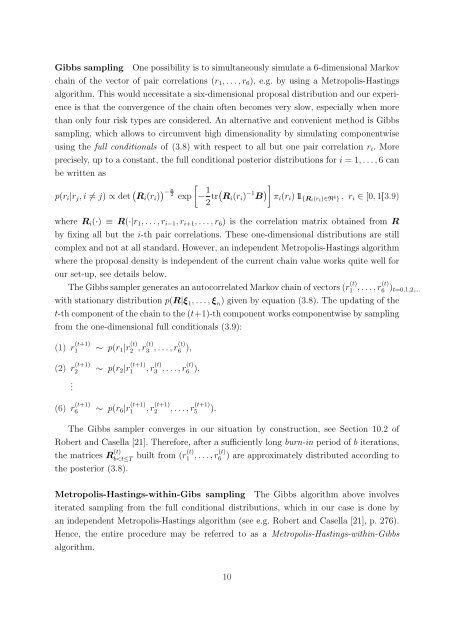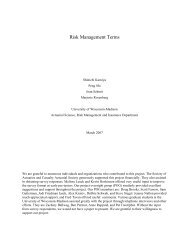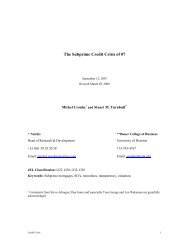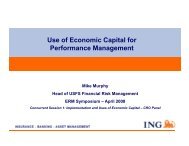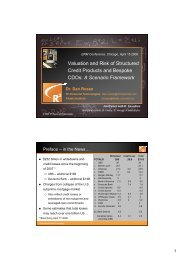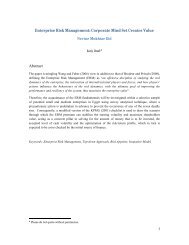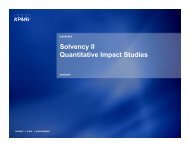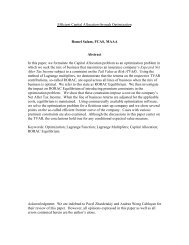Bayesian Risk Aggregation: Correlation ... - ERM Symposium
Bayesian Risk Aggregation: Correlation ... - ERM Symposium
Bayesian Risk Aggregation: Correlation ... - ERM Symposium
Create successful ePaper yourself
Turn your PDF publications into a flip-book with our unique Google optimized e-Paper software.
Gibbs sampling One possibility is to simultaneously simulate a 6-dimensional Markov<br />
chain of the vector of pair correlations (r1, . . . , r6), e.g. by using a Metropolis-Hastings<br />
algorithm. This would necessitate a six-dimensional proposal distribution and our experi-<br />
ence is that the convergence of the chain often becomes very slow, especially when more<br />
than only four risk types are considered. An alternative and convenient method is Gibbs<br />
sampling, which allows to circumvent high dimensionality by simulating componentwise<br />
using the full conditionals of (3.8) with respect to all but one pair correlation ri. More<br />
precisely, up to a constant, the full conditional posterior distributions for i = 1, . . . , 6 can<br />
be written as<br />
p(ri|rj, i = j) ∝ det Ri(ri) − n<br />
<br />
2 exp − 1<br />
2 trRi(ri) −1 B <br />
πi(ri) 1 {Ri(ri)∈R4 } , ri ∈ [0, 1](3.9)<br />
where Ri(·) ≡ R(·|r1, . . . , ri−1, ri+1, . . . , r6) is the correlation matrix obtained from R<br />
by fixing all but the i-th pair correlations. These one-dimensional distributions are still<br />
complex and not at all standard. However, an independent Metropolis-Hastings algorithm<br />
where the proposal density is independent of the current chain value works quite well for<br />
our set-up, see details below.<br />
The Gibbs sampler generates an autocorrelated Markov chain of vectors (r (t)<br />
1 , . . . , r (t)<br />
6 )t=0,1,2,...<br />
with stationary distribution p(R|ξ 1, . . . , ξ n) given by equation (3.8). The updating of the<br />
t-th component of the chain to the (t+1)-th component works componentwise by sampling<br />
from the one-dimensional full conditionals (3.9):<br />
(1) r (t+1)<br />
1<br />
(2) r (t+1)<br />
2<br />
.<br />
(6) r (t+1)<br />
6<br />
∼ p(r1|r (t)<br />
2 , r (t)<br />
3 , . . . , r (t)<br />
6 ),<br />
∼ p(r2|r (t+1)<br />
1 , r (t)<br />
3 , . . . , r (t)<br />
6 ),<br />
∼ p(r6|r (t+1)<br />
1<br />
, r (t+1)<br />
2<br />
, . . . , r (t+1)<br />
5 ).<br />
The Gibbs sampler converges in our situation by construction, see Section 10.2 of<br />
Robert and Casella [21]. Therefore, after a sufficiently long burn-in period of b iterations,<br />
the matrices R (t)<br />
b


